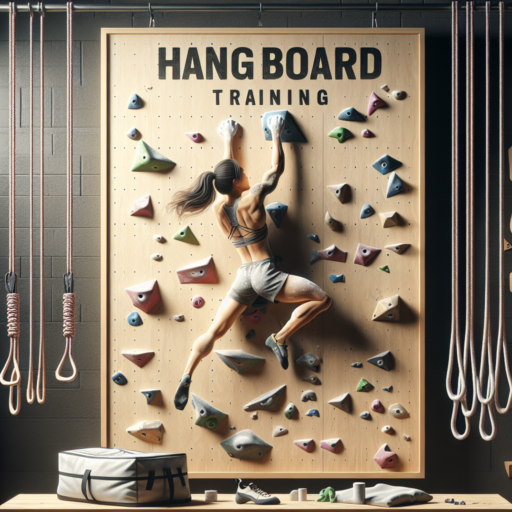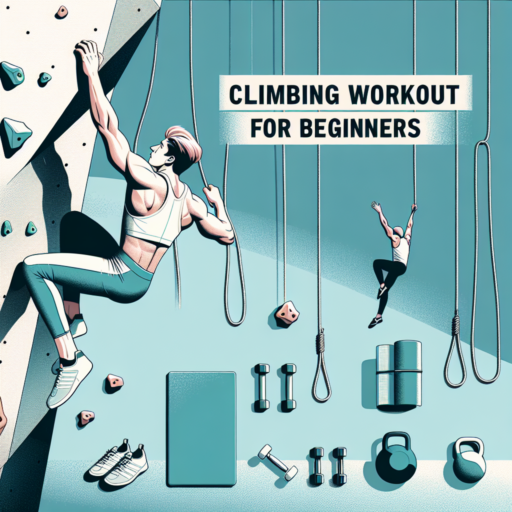The Ultimate Guide to Hangboard Training for Beginners
Embarking on your journey into hangboard training as a beginner can seem daunting at first. With the right approach, however, you can build grip strength, endurance, and overall climbing prowess. This ultimate guide is designed to facilitate your initiation into this effective training method, ensuring safety and progression are at the forefront of your practice.
Understanding the Basics of Hangboard Training
Hangboard training involves using a small, mounted board with various holds and grips to simulate climbing. It’s a focused method to improve finger strength and technique for rock climbing and bouldering. For beginners, familiarizing yourself with the different types of holds (like edges, crimps, and pockets) and grip techniques is essential. Start with basic holds and gradually progress to more challenging grips to prevent injury and build strength more effectively.
Creating Your First Hangboard Routine
Constructing a hangboard routine that caters to your level is key to success. Beginners should focus on short sessions, around 20-30 minutes, twice a week. It’s important to include a proper warm-up to minimize the risk of injury. Incorporate exercises that engage your fingers, wrists, and arms before starting your hangboard workout. Consider starting with dead hangs from comfortable holds, gradually increasing the difficulty as your strength improves.
Integrating hangboard training into your climbing regimen can significantly enhance your climbing ability. With patience, dedication, and adherence to these foundational principles, beginners can make substantial gains. Remember, consistency is more critical than intensity in the early stages, so focus on building a sustainable practice that supports long-term improvement and enjoyment in the sport of climbing.
Top Hangboard Exercises to Boost Your Climbing Strength
Improving your climbing strength demands dedicated training and precision exercises. Among the numerous tools available to climbers, the hangboard stands out as a fundamental piece of equipment for developing grip strength, endurance, and finger power. Incorporating specific hangboard exercises into your routine can significantly enhance your climbing performance. Below, we delve into some top exercises designed to boost your climbing strength efficiently.
Dead Hangs
Dead hangs are the cornerstone of hangboard training, focusing on improving grip endurance and finger strength. This exercise involves hanging from the hangboard with both hands for a set amount of time, typically ranging from 10 to 30 seconds. It’s essential to maintain proper form by engaging your core and shoulders, and evenly distributing your weight. Over time, dead hangs can drastically increase your ability to hold onto small holds and ledges while climbing.
Repeaters
Repeaters are designed to build endurance and power by repeating a sequence of hanging and resting. This involves hanging from the board for 7 seconds, followed by resting for 3 seconds, and repeating this sequence for a set number of repetitions. By varying the grip positions, climbers can target different muscles and improve overall hand strength. The dynamic nature of repeaters makes them an excellent exercise for climbers looking to mimic the intensity and endurance required during actual climbs.
Finger Pull-ups
For those looking to increase finger strength and precision, finger pull-ups are incredibly effective. This advanced exercise requires pulling yourself up slightly using only your fingers, then holding for a few seconds before lowering back down. It’s crucial to start with larger holds and gradually progress to smaller grips as your strength improves. Finger pull-ups not only enhance finger power but also contribute to better control and efficiency in gripping climbing holds.
How to Set Up Your Hangboard for Effective Training at Home
Setting up a hangboard in your home can transform your climbing training routine, offering an effective way to develop grip strength, endurance, and finger strength. Before you begin, ensuring your hangboard is properly mounted is crucial for both your safety and the effectiveness of your workouts. Here, we delve into the essentials of setting up your hangboard to maximize your training outcomes.
Choosing the Right Location
Space and Positioning: First and foremost, selecting the optimal location within your home is key. You’ll need a space that allows for full range movement around the board without obstructions. Typical places include door frames, above doorways, or on a sturdy wall that can support your weight and the dynamic nature of hangboard exercises.
Installation Tips
Mounting Your Hangboard: When it comes to installing the hangboard, making sure it’s securely attached is paramount. It’s often recommended to mount the board on a wooden backing that’s firmly fixed to the wall studs, ensuring it can bear the load of repetitive use. Utilize heavy-duty screws and, if possible, enlist the help of a professional to verify the stability and safety of the installation. Once mounted, verify all mounts and supports are tight and regularly inspect them for any signs of wear or loosening.
Height and Reachability: Adjust the hangboard’s height according to your own reach and the types of exercises you plan to perform. It should be high enough to hang freely but low enough for you to reach without jumping, minimizing injury risk. Additionally, consider the ergonomics of its position to facilitate a natural posture during exercises, which is essential for preventing strains.
Understanding the Science Behind Hangboard Training Success
Hangboard training has emerged as a pivotal exercise for climbers looking to enhance their grip strength, endurance, and overall climbing performance. At its core, hangboard training success is deeply rooted in the principles of sports science, particularly in the domains of muscular adaptation and neurological efficiency. By exploring the scientific mechanics behind this training methodology, climbers can optimize their routines for maximum gains.
Initially, the concept of specificity in workout routines is fundamental in understanding why hangboard training is so effective. This principle dictates that to improve in a particular skill or strength area, the training must closely mimic the actions and stresses of that activity. Hangboards provide a controlled environment where climbers can replicate the grip and hold types found in actual climbing scenarios, thereby eliciting specific muscular and neurological adaptations. These adaptations include increased finger strength, improved tendon resilience, and enhanced neuromuscular coordination, all of which are critical for climbing success.
Furthermore, the science of progressive overload plays a crucial role in hangboard training advancements. This concept involves gradually increasing the difficulty of exercises to continue challenging the muscles, thereby fostering strength and endurance improvements over time. Through systematic increases in hang time, reduction in hold size, or addition of weight, climbers can induce progressive muscular adaptation without plateauing. Such incremental adjustments ensure continuous development and prevent overtraining injuries by respecting the body’s natural adaptation process.
Creating a Hangboard Workout Plan: Tips and Techniques
Developing a robust hangboard workout plan is essential for climbers looking to improve their grip strength, endurance, and overall performance. Understanding the fundamentals of crafting an effective routine is key to achieving your climbing goals. Here, we delve into practical tips and techniques to guide you through creating a personalized hangboard regimen.
Identifying Your Climbing Objectives
Before jumping into hangboard training, it’s crucial to define your climbing objectives. Are you aiming to increase endurance, enhance grip strength, or both? Knowing your goals will shape the structure and intensity of your workout plan. It’s important to tailor your hangboard sessions to directly support these objectives, focusing on specific grips or holds that mimic your climbing projects.
Structuring Your Hangboard Sessions
Effective hangboard workouts are grounded in structure. Start by integrating warm-up exercises to prepare your muscles and tendons, reducing the risk of injury. A typical hangboard regimen should alternate between periods of hanging and rest, with variations in grip styles to comprehensively train different muscle groups. Beginners should focus on mastering basic grips with longer rest intervals, gradually increasing intensity and reducing rest periods as they progress. Incorporating recovery days into your schedule is vital to allow for muscle repair and growth.
Remember, consistency is key in any training regimen. Setting a regular schedule and progressively challenging yourself within safe limits will lead to notable improvements in your climbing performance. Always listen to your body and adjust your workout plan as needed to prevent overtraining and ensure continuous progression.
The Importance of Rest and Recovery in Hangboard Training
When engaging in the rigorous practice of hangboard training, the significance of rest and recovery phases cannot be overstated. It’s not just about the intensity and frequency of your training sessions, but equally about how well you allow your body to recuperate. This balanced approach is pivotal for both enhancing performance and preventing injuries.
Rest periods play a critical role in the process of muscle repair and growth. During hangboard sessions, the muscles and tendons in the hands and forearms are subjected to high levels of stress. It’s during rest that the body repairs these microtears, which, in turn, leads to stronger and more resilient muscle fibers. Neglecting adequate recovery can lead to overuse injuries, such as tendinitis, which could sideline an athlete for weeks, if not months.
Moreover, recovery strategies such as active rest, proper nutrition, and hydration are fundamental in maximizing the benefits of hangboard training. Active rest, incorporating activities that are low in intensity and different from hangboarding, helps in maintaining general fitness while allowing specific muscle groups to recover. Coupling this with a diet rich in nutrients and adequate hydration ensures the body has all it needs to repair itself effectively.
Measuring Your Progress: Key Metrics in Hangboard Training
Monitoring your progress during hangboard training is crucial to ensure consistent improvement and motivation. Focusing on specific metrics helps in crafting a more effective training regimen and avoiding plateaus. Key metrics to consider include hang time, hold size, and grip strength. By keeping an eye on these variables, climbers can gauge their performance levels and set realistic targets for their next sessions.
Hang time is a fundamental metric in hangboard training. It refers to the duration one can maintain a grip on a hold. Initially, improvements may be seen rapidly, but as you progress, increasing your hang time becomes more challenging and requires more structured training. Implementing structured rest periods and progressively increasing the difficulty of the holds are strategies that can help extend your hang time effectively.
The hold size
is another critical metric. As you progress, gradually reducing the size of the holds can significantly improve your finger strength and endurance. Starting with larger grips and slowly transitioning to smaller ones allows for a measurable way to see improvements. Additionally, diversifying the type of holds (e.g., crimps, slopers) can aid in developing a well-rounded grip strength.
Incorporating these key metrics into your hangboard training program not only provides a structured approach to your workouts but also instills a sense of progression and achievement. Tracking your hang time, experimenting with different hold sizes, and steadily increasing your grip strength are integral steps towards enhancing your climbing abilities.
Common Mistakes to Avoid in Hangboard Training
When engaging in hangboard training, enthusiasts often fall prey to a handful of common mistakes. These errors can not only hinder progress but also increase the risk of injury. Bearing in mind a few key practices can significantly optimize the training experience, ensuring both safety and effectiveness.
Ignoring Proper Warm-Up
One of the most critical oversights is skipping the warm-up session. Hangboarding puts a significant strain on the fingers, wrists, and arms. Engaging in exercises without adequately preparing these muscles can lead to strains or more severe injuries. A thorough warm-up enhances flexibility and blood flow, reducing the risk of muscle tears and tendonitis.
Overtraining
Another common mistake is overtraining. In the zeal to achieve rapid improvements, individuals often disregard the importance of rest and recovery. Overworking the muscles can lead to overuse injuries and hinder gains rather than fostering them. It’s crucial to listen to your body and incorporate rest days into your training routine to allow for recovery and growth.
Neglecting Technique
Focusing solely on hanging time and ignoring technique is a grave mistake. Proper form is paramount for maximizing the effectiveness of hangboard training while minimizing the risk of injury. Beginners, in particular, should prioritize learning the correct form, such as how to engage their shoulders and maintain a neutral wrist position, before intensively increasing hang time or adding weight.
Incorporating Hangboard Training into Your Overall Climbing Regimen
Adding hangboard training to your climbing routine can significantly boost your grip strength and overall climbing performance. This specialized form of training involves hanging from a board with various grips, simulating the challenging holds you encounter on rock faces or climbing walls. To effectively integrate this into your existing regimen, it’s crucial to strike a balance between hangboard sessions and other climbing activities.
Understanding Hangboard Basics
Before diving into hangboard training, familiarize yourself with the basic hold types, including edges, slopers, and pockets. Start with a comprehensive warm-up to prepare your muscles and tendons for the intense grip work. Initially, focus on shorter, less intense sessions to acclimatize your body and reduce the risk of injury.
Designing a Balanced Training Schedule
To harmoniously blend hangboard training with your climbing regimen, aim for a structured weekly schedule that allows sufficient rest and recovery. A typical approach might include two hangboard sessions, complemented by two to three days of climbing. This ensures that you’re not only working on grip strength but also honing your climbing skills and technique. Remember, adequate rest is key to muscle recovery and overall progress.
Incorporating hangboard training requires careful consideration of intensity, frequency, and recovery. By starting slow, focusing on technique, and listening to your body, you can make hangboard training a valuable addition to your comprehensive climbing regimen, leading to improved performance and resilience on the wall.
No se han encontrado productos.
Advanced Hangboard Training Techniques for Experienced Climbers
Experienced climbers are always on the lookout for methods to push their limits and enhance their skills. Advanced hangboard training techniques play a pivotal role in this quest for improvement, targeting grip strength, endurance, and precision. This specialized form of training leverages the simplicity of the hangboard to deliver a profoundly effective workout, focusing on the nuanced needs of advanced climbers seeking to elevate their performance.
Integrating Dead Hangs with Added Weight
One significant advanced technique is the integration of dead hangs with added weight. This method not only amplifies the intensity of the workout but also simulates the increased demands of climbing harder routes. By carefully adding weight through a harness or a weighted vest, climbers can progressively overload their muscles, leading to substantial gains in both grip strength and forearm endurance. It’s crucial, however, to increase the weight incrementally to avoid injury and ensure consistent progress.
Variable Edge Training for Grip Diversity
Another essential technique is variable edge training, which involves alternating between different edge sizes on the hangboard. This tactic challenges the climber’s fingers in varying degrees, from wider holds that demand more from the palm and forearm to narrower edges that rely heavily on finger strength. By varying the edge size, climbers can target specific weaknesses in their grip, facilitating balanced development across all finger and hand muscles. Engaging in this form of training not only boosts one’s ability to handle a variety of hold types but also significantly enhances endurance for longer, more challenging climbs.
Dynamic Hangboard Movements
For those looking to incorporate a dynamic component into their hangboard regimen, integrating movement-based exercises can offer substantial benefits. Execute techniques like pull-ups or typewriter pulls on the hangboard to introduce dynamic movements that mirror the unpredictability of real climbs. These exercises promote muscle engagement across a broader range, fostering improvements in overall climbing agility and power. Furthermore, the inclusion of dynamic movements helps in the reduction of injury risks by better preparing the muscles for the varied stresses encountered during climbs.




